The hotel is located near one of the most important motorways of Sicily, strategic starting point for discovering the wonders of the island.
The city of Palermo can be reached in about 40 minutes on the highway, the town of Cefalu is 15 minutes away by car.
Castelbuono
Heading from Pollina towards the hinterland, a winding road leads you to Castelbuono, a village of Byzantine origin. The area is typical for its huge forests of manna ash trees.
Worth a visit: the castle in its peculiar shape of Medieval manor. The Minà museum, where natural and historical collections assembled in the 14th century are on display.

Cefalù
Seaside and bathing resort about 14km away from Campofelice di Roccella, Cefalù is considered as the gateway to the Madonie mountains. Its origins most probably date back to the 5th century BC. Its name can be traced back to the Greek word Kephaloidion (head), from the shape of its overhanging crag. The name was then turned into the local dialect form Cifalò and, later on, into Cefalù. The town flourished dramatically throughout the Norman period.
Places to visit:
- The Norman cathedral. Built between 1130 and 1471, it houses the gorgeous mosaics of the Christ Pantocrator, a painted wooden cross ascribed to Guglielmo da Pesaro and the sixteenth-century statue of Madonna and Child by Gagini;
- The Osterio Magno (formerly King Roger’ Palace);
- The Mandralisca Museum, which contains a wonderful range of very well-preserved craters. Among these, the most renowned one is a fourth-century-BC crater which depicts a fishmonger cutting tuna fish.
- The Temple of Diana, perched on the top of the promontory above the town.
Cerda
Driving back to the coast, towards Campofelice di Roccella (less than 20km away) you find Cerda, a village renowned for artichoke farming.
Gangi
This ancient village rich in traditions and popular festivals is about 60 km away from Enna. Festivals of archaic pagan origin are celebrated in summer, such as the ‘Ear of corn festival’ and the ‘Burgisi festival’.
Worth a visit: the huge Ventimiglia’s tower and the main church, which houses some excellent paintings by G. Salerno, better known as lo zoppo di Gangi (the cripple from Gangi) (1629).
What not to miss: some churches such as Chiesa della Catena and San Cataldo, the Ventimiglia’s castle, and Palazzo Bongiorno with frescoes by Fumagalli.
Geraci Siculo
Dell'antico castello rimangono solo pochi suggestivi ruderi e la piccola chiesa di Sant'Anna, che fu la cappella palatina dei Ventimiglia. All'interno della chiesa madre, dall'interessante architettura romanico-gotico, si conservano tele probabilmente opera del Gagini. Nel centro storico del paese è stata ricostruita una grande falconiera, per l'addestramento e l'allevamento di falchi da caccia. Interessante il Bevaio Saraceno, la cui acqua è nota per le proprietà oligominerali.
Polizzi Generosa
Polizzi is a town of medieval origin perched on top of a rock at a height of 900m.
It is well-known for its handicraft, particularly embroidery and wrought iron, as well as for its gastronomic delights, such as the sfoglio (typical cheese dessert) and the buccellati with honey and dried figs.
Climbing up to 1,600m you can reach Piano Battaglia, a ski resort with skiing facilities and mountain huts.
Pollina
Still along the coastline, you may find the small seaside village of Finale di Pollina, a suburb hamlet of Pollina. It bounds the province of Palermo to the east with its crystal-clear seawater. Several landmarks of the hamlet’s history can be enjoyed in its historic centre.
Worth a visit: the Main Church, built in the 19th century and dedicated to Saints John and Paul. It houses a number of works by local artists and a valuable fifteenth-century organ.

The Madonie Park
The park, created in 1989, occupies about 40,000 hectares and includes the Madonie mountain range. It is bounded between the Imera and the Pollina river. Thanks to its 15,000 hectares of woodland, it can be considered as Sicily’s green lung. Pizzo Carbonara (1,979 m) is its highest peak. The park hosts over a half of the Sicilian plant species. Some are endemic ones, such as the Sicilian fir tree (Abies nebrodensis), which grows only in the Madonna degli Angeli valley (currently 31 specimens).
As much diversified is the park fauna. Among carnivores, foxes, wildcats, and pine martens are common. Typical rodents are the European dormouse, the dormouse, and the garden dormouse. Moreover, birds of prey include some rare species such as the Egyptian Vulture, the last vulture species still existing in Sicily, along with the peregrine falcon. Finally, 30 endemic species of insects, among which the Mountain Apollo (Parnassius Apollo), a pale-coloured butterfly that can be found only in mountain habitats.
The park encompasses 15 villages, namely Caltavuturo, Castelbuono, Castellana, Cefalù, Collesano, Geraci Siculo, Gratteri, Isnello, Petralia Soprana, Petralia Sottana, Polizzi Generosa
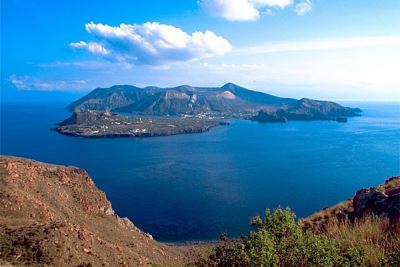
Aeolian Islands
The ‘seven sisters’ immortalised in Homer’s Odyssey and Virgil’s Aeneid are a magic place evoking thousands of years of history. Seven islands where the four natural elements – earth, air, fire and water – produced such stunning spots that the place has been inscribed in the UNESCO world heritage list. A full array of colours can be appreciated across the archipelago, offering a unique experience of the senses: its yellow sulphur in Vulcano, its white pumice stone and black obsidian in Lipari, its red lava in Stomboli, its blue and green seawater and golden beaches create a natural masterpiece.
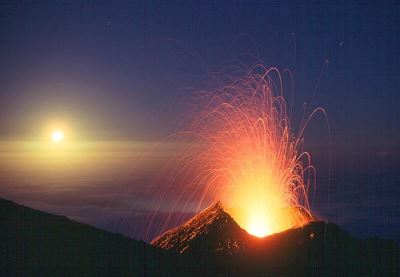
Etna Park
Etna is the highest active volcano in Europe. Visiting it involves entering a world characterised by beds of lava and on-the-spot volcanic phenomena that can be seen live. Climbing the mountain’s slopes where lava blocks are cooled and hardened, you can walk through pine and beech woods which harbour rich and varied wildlife: wolves, wild boars, golden eagles, fallow deers and roe deers. Moreover, park itineraries also include tasting local specialities such as delicious cheese, fine mushrooms, pistachio nuts, hazelnuts, and wine. Its wine varieties have a registered designation of origin thanks to the place’s peculiar climate, pedological and farming conditions.
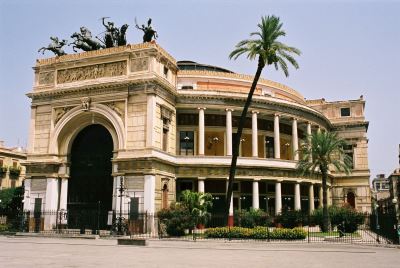
Palermo
The capital of Sicily, it is Italy’s fifth largest city. The various peoples who ruled over it and characterised its history gave the city its contrasting fascination and yet its undeniable beauty. Among its most significant monuments the Palazzo dei Normanni (Norman Palace), seat of the oldest parliament in Europe, the Castle of Zisa with its lush gardens, the Teatro Massimo and Teatro Politeama, two magnificent examples of neo-Classical style and via della Libertà, the city’s high street where it is possible to stroll around fine art nouveau residences.

Taormina
Authentic pearl of the Mediterranean set between luxuriant hills and white Ionian shores, Taormina is one of the most picturesque Sicilian seaside resorts.
Thanks to its elegant high-street shops (corso Umberto I), trendy restaurants and cafés, and its various art and culture events, Taormina has now regained the past magnificence it had during the belle époque. Famous personalities such as Sigmund Freud, Albert Einstein, Truman Capote, D.H. Lawrence, Greta Garbo and Liz Taylor sojourned here, encouraging a kind of elite tourism.
Some spots are not to be missed, namely Palazzo Corvaja, the very well-kept town centre, and the Greek-Roman theatre, which still hosts art performances and concerts in summertime.
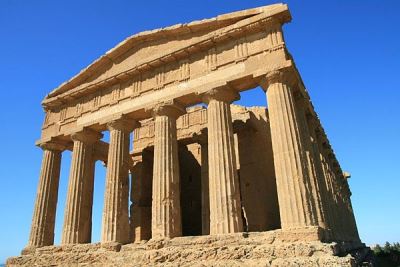
Valley of the temples
Situated close by to Agrigento, the Valley of the temples is a major testimony to the ancient Greeks’ presence in Sicily. It as been a UNESCO world heritage site since 1997. Here it is possible to admire the remains of 7 Greek temples of the classical period, among which stands out the Temple of Concord, dedicated to Juno and still well preserved in its main features. This year-round destination is worth visiting especially in early Spring, when the “Sagra del Mandorlo in Fiore” (Almond blossom festival) features the temples’ age-old beauty, spotless almond blossoms and tasty Sicilian delicacies.
Caccamo
It is a clear sign of the Muslim presence in the area. The history of Caccamo is deeply linked to that of its castle: over the centuries, it has been restored and enlarged by the various rulers who succeeded each other.
One of the largest and best-preserved in Sicily, the castle was built in the Norman period by the Chiaramonte family. It contains the stables, a chapel, a theatre hall, the main tower, the servants’ quarter, the conspiracy hall, the arms room and the prisons.
Campofelice di Roccella
Founded on the site of an ancient hamlet, the village of Campofelice di Roccella was named after the fertile ground where it is located.
The tower, Torre Roccella, is worth visiting. Dating back to the 14th century, it was part of a small Arab fortress built to defend the surrounding land.
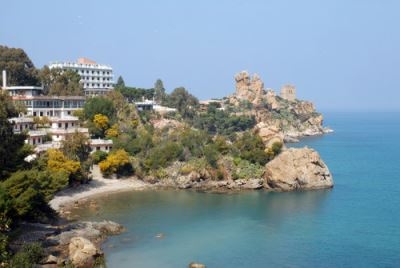
Himera
One of the most flourishing Greek cities in Sicily, it was established in 648 BC by Syracusan exiles and Chalcidian inhabitants of Zancle (the present-day Messina).
The city has been the scene for great historical events. The remains of some neighbourhoods are still visible. Another historical highlight is the temple of Victory, erected to celebrate the winning armies from Siracusa and Acragas (the present-day Agrigento) over the Carthaginians. Archaeological findings from the whole area are on display in the antiquarium, including the ‘lovers’ grave’.
Solunto
The ruins are about 15km away from Palermo, at the foot of Mount Catalano, near Santa Flavia. The settlement overlooks the Gulf of Cefalù from its top-hill position. It was an ancient outpost of Phoenician origin, later inhabited by the Greeks and Romans. The visible remains date from the Hellenistic period (4c BC). These include a theatre, a gymnasium as well as a large manor house with an atrium and a peristyle with columns.
Termini Imerese
The history of this town goes back to the 5th century BC, when inhabitants from the destroyed Himera took refuge in a settlement called Thermae by the Carthaginians.
It was later conquered by the Romans in 251 BC and attacked by the Arabs in 828.
According to the myth, Hercules himself made use of its wholesome thermal baths after his twelve labours. The present thermal spa has been rebuilt on the ruins of the previous establishment in the 17th century.
Worth a visit: the former convent of Poor Clares, which contains the Biblioteca Liciniana, a renowned library. Moreover, the relics of a Roman Amphitheatre, which could accommodate an audience of up to 4,000 people, as well as the Cornelius aqueduct (2c BC).
Trabia
Its current name is derived from the Arabic word Attarbi 'ah (the square-shaped, from the original shape of its castle). A historical document from the 1154 designated Trabia as the home of spaghetti as it makes reference to the number of mills where a wiry kind of noodles was produced. This was called itrya and exported across the Norman kingdom.
Worth a visit: the castle, whose date of construction is unknown, although evidence of it was revealed as early as 747. Furthermore, the Chapel of Saint Rosalie and the small harbour of Saint Nicola l’Arena.





